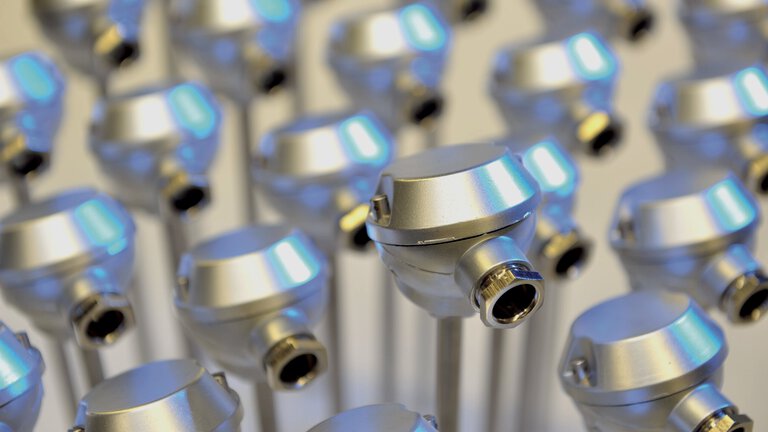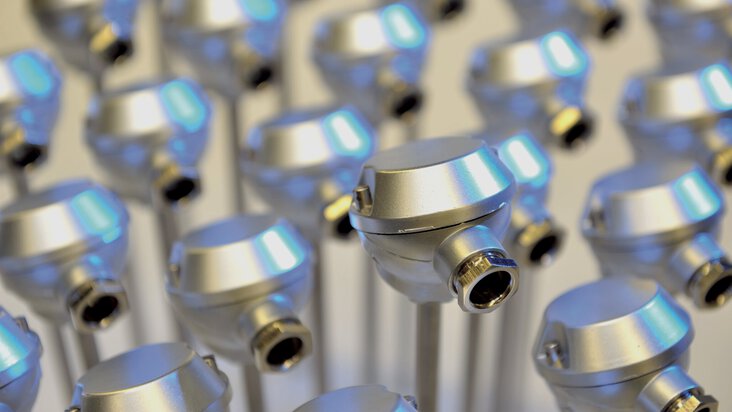
Pt1000 – The most important details in a nutshell
The Pt1000 is an accurate temperature sensor in measurement and control engineering as part of a resistance thermometer. Another common designation is RTD, Resistance Temperature Detector, although this includes other types of sensors.Learn more about the Pt1000 sensor!
Table of Content
What is a Pt1000?
The Pt1000 is a Platinum sensor element that is part of a resistance temperature sensor. The sensor has a resistance of 1000 Ohms at 0°C.
Where does the name Pt1000 come from?
"Pt" is the abbreviation for Platinum, the material of the measuring resistor. The numeral 1000 stands for the nominal resistance at 0°C, i.e. 1000 Ohms.
How does a Pt1000 sensor work?
The platinum material has a temperature-dependent electrical resistance, This resistance is almost rectilinear with temperature changes. This is because electrical conduction in materials is caused by electrons moving freely between atoms. If the movements of the atoms become more active with temperature increase, the electrons will encounter more resistance in passing through the atoms, thus increasing the electrical resistance in the material.
The resistance value of a Pt1000 according to the European standard is RPt1000 = 1000 + 3.85055 × T. Thus, the positive temperature coefficient of a Pt1000 is 3.85055 ohms per kelvin. Another accurate approximation is: RPt1000 = (1000 + 3.90802 × T - 0.000580195 × T^2).
What are the advantages of a Pt1000?
Along with the Pt100, the Pt1000 is one of the most frequently used industrial temperature sensors. This is due not least to its numerous advantages. These include:
- Large measuring range
- Linear
- Long service life
- Accurate and reproducible
What is the difference between a Pt100 and a Pt1000?
The Pt100 has a resistance of 100 Ohms at 0°C and the Pt1000 has a resistance of 1000 Ohms at 0°C. A Pt1000 is linear and measures temperature differences more accurately.
What resistance values does a Pt1000 have?
The Pt100 has a resistance of 100 Ohms at 0°C and the Pt1000 has a resistance of 1000 Ohms at 0°C. Both are linear and measure equally accurately. The advantage of a Pt1000 is that the resistance of the sensor assembly is a factor of 10 smaller on the measurement result.
Pt1000 resistance reference values in 1°C increments
|
°C
|
0 |
1 |
2 |
3 |
4 |
5 |
6 |
7 |
8 |
9 |
|
0 |
1000,00 |
1003,91 |
1007,81 |
1011,72 |
1015,62 |
1019,53 |
1023,43 |
1027,33 |
1031,23 |
1035,13 |
|
10 |
1039,03 |
1042,92 |
1046,82 |
1050,71 |
1054,60 |
1058,49 |
1062,38 |
1066,27 |
1070,16 |
1074,05 |
|
20 |
1077,94 |
1081,82 |
1085,70 |
1089,59 |
1093,47 |
1097,35 |
1101,23 |
1105,10 |
1108,98 |
1112,86 |
|
30 |
1116,73 |
1120,60 |
1124,47 |
1128,35 |
1132,21 |
1136,08 |
1139,95 |
1143,82 |
1147,68 |
1151,55 |
|
40 |
1155,41 |
1159,27 |
1163,13 |
1166,99 |
1170,85 |
1174,70 |
1178,56 |
1182,41 |
1186,27 |
1190,12 |
|
50 |
1193,97 |
1197,82 |
1201,67 |
1205,52 |
1209,36 |
1213,21 |
1217,05 |
1220,90 |
1224,74 |
1228,58 |
|
60 |
1232,42 |
1236,26 |
1240,09 |
1243,93 |
1247,77 |
1251,60 |
1255,43 |
1259,26 |
1263,09 |
1266,92 |
|
70 |
1270,75 |
1274,58 |
1278,40 |
1282,23 |
1286,05 |
1289,87 |
1293,70 |
1297,52 |
1301,33 |
1305,15 |
|
80 |
1308,97 |
1312,78 |
1316,60 |
1320,41 |
1324,22 |
1328,03 |
1331,84 |
1335,65 |
1339,46 |
1343,26 |
|
90 |
1347,07 |
1350,87 |
1354,68 |
1358,48 |
1362,28 |
1366,08 |
1369,87 |
1373,67 |
1377,47 |
1381,26 |
|
100 |
1385,06 |
1388,85 |
1392,64 |
1396,43 |
1400,22 |
1404,00 |
1407,79 |
1411,58 |
1415,36 |
1419,14 |
What is the deviation of a Pt1000?
The deviation a Pt1000 is allowed to have depends on its class and temperature. See figure.
ltl = Delta T in K relative to 0° C

Pt1000 specifications according to DIN EN 60751
Why does a Pt1000 sensor need to be calibrated?
For maximum measurement accuracy, it is recommended that the Pt1000 be calibrated once a year. Calibration can be performed using a reference pressure sensor or by manual on-site calibration.
What types of Pt1000 are available?
The platinum wire is traditionally wound on an insulating core of glass or ceramic. Nowadays, mainly chip versions with connecting wires or on PCB are produced. Loose SMD versions are also possible.
At what temperature can a Pt1000 be used?
The Pt1000 can be used between -200°C and +800°C. This is related to the other requirements of the application.
When is a 2-, 3- or 4-wire connection used?
The use of a 2-, 3- or 4-wire connection depends primarily on the type of sensor assembly and the measurement accuracy required.
Two-wire connection
This is always used when no very precise measurement is required. A two-wire connection is simple and inexpensive.
Three-wire connection
By compensating for the conductivity of the connecting cable, a 3-wire connection measures much more accurately. This is especially true when long connecting cables are used. Therefore, a three-wire connection is often used in practice.
Four-wire connection
A four-wire connection measures most accurately because with this measurement method, a separate reference voltage is used to eliminate internal resistors. This is especially useful when high accuracy is required and the measurement circuit has a significant resistance component.
- ${title}${badge}


